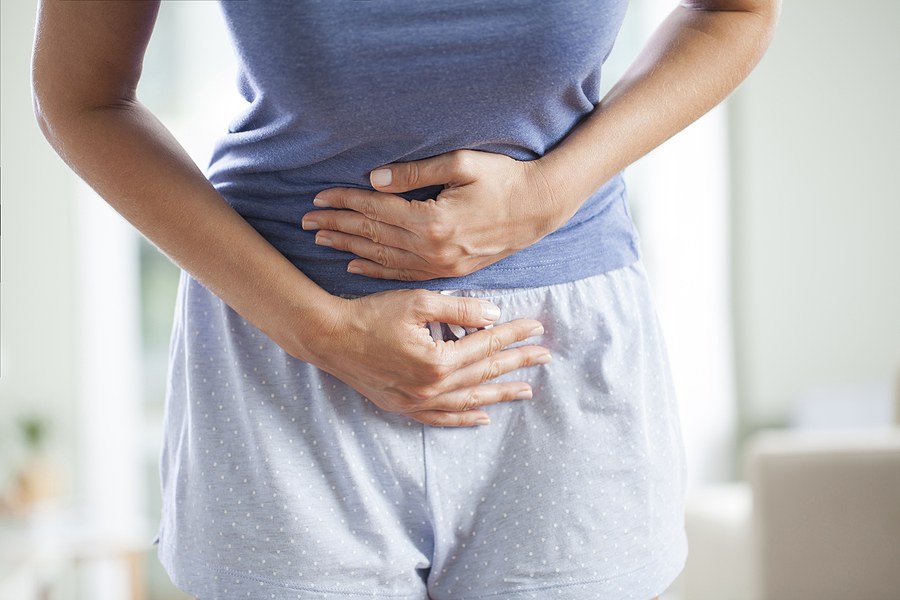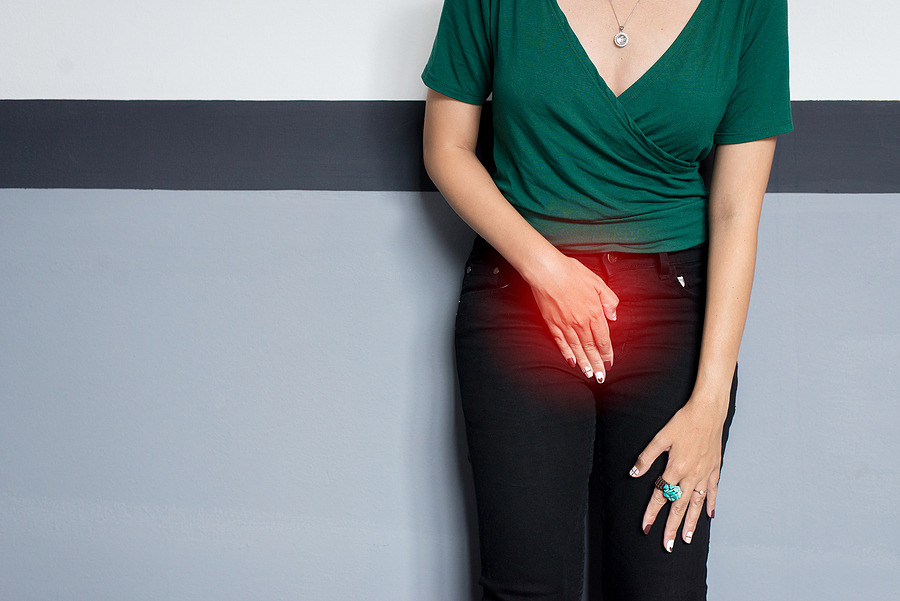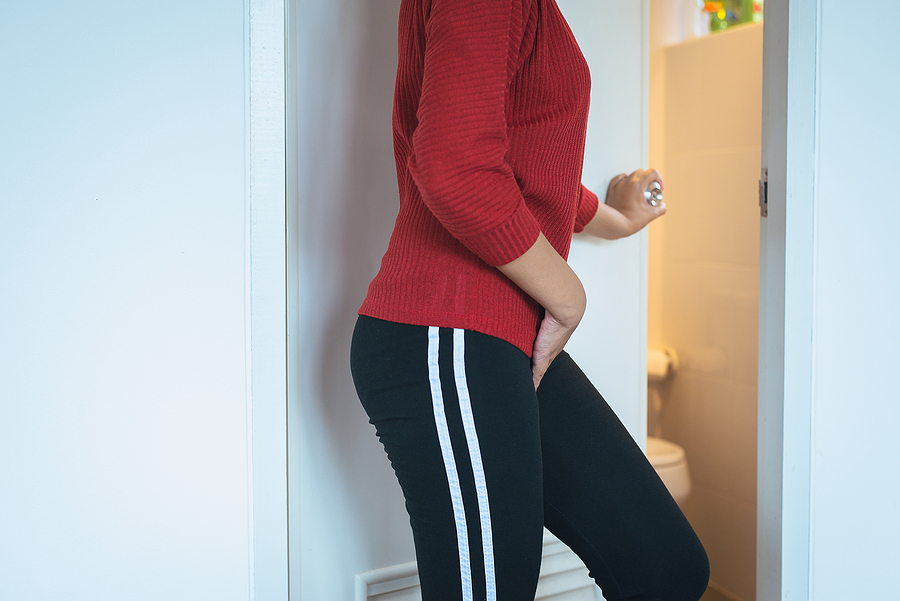Updated 11/01/2020
Don’t just live with urinary incontinence — learn about the causes of incontinence and what you can do about it! Here are the topics discussed in this article:
- What causes incontinence in women?
- Urinary incontinence after hysterectomy
- Bladder problems after menopause
- The emotional connection
- The problem with surgical solutions
- Natural Urinary incontinence treatments
I was out with my friend Krystal recently, and I noticed that she excused herself to use the restroom four times in less than an hour. While many people may have pretended not to notice, I couldn’t help but ask her if this was a frequent problem. She sighed and said yes, and that she also had to wear an absorbent pantyliner everwhere she went because sometimes she just didn’t get to a toilet quickly enough. Coughing, sneezing, and even laughing were also problems, she said. Though incontinence and an overactive bladder were seriously impacting her life, she seemed resigned to having to deal with it unless she wanted to have surgery or take medication indefinitely.
I told her that it sounded like she was suffering from both stress and urge incontinence. She was thrilled when I told her that there are natural solutions that can really help reduce these problems. It’s unfortunate that so many women out there feel the same way my friend did – that incontinence is caused by something they can’t do anything about.
Let’s take a look at the root causes behind incontinence and then I’ll offer some natural treatment solutions that can help you regain control of your bladder – and your life!
What causes incontinence in women?
Sometimes the smooth muscle of the vaginal wall or the perineum stretches too much and herniates, allowing the bladder or urethra to balloon through the weakened muscle. This herniation creates a pocket in the vagina known as a cystocele or urethrocele, which makes it difficult to fully empty the bladder or stretches the opening of the urethra, causing stress incontinence. You can usually feel a cystocele or urethrocele as a smallish, smooth bulge in the anterior (front) or side wall of your vagina. Overstraining, childbirth, and injury are the most common causes of cystoceles and urethroceles prior to menopause. After menopause, the natural thinning of the muscles is the more common culprit.
Chronic infection, surgery, medications (including synthetic HRT), radiation, adhesions, and disease are other factors that affect bladder function and the architecture of the muscles and nerves in the pelvis — and they can all contribute to issues with incontinence.
You are more likely to develop urinary incontinence if you have had significant trauma to the pelvis, spine or bladder, surgery, a disability or impaired mobility (which can make it hard to get to the bathroom). We often see a connection between incontinence and a car accident that occurred years beforehand, especially when those accidents were followed by a change in posture or chronic pain. Stroke, Alzheimer’s, multiple sclerosis (MS), and other central nervous system conditions are also associated with urinary incontinence.
Systemic yeast, local yeast infections, and food allergies also play a role in bladder infections and interstitial cystitis. And, as in all inflammatory conditions, our emotions play a role in fueling the fire. For more information, see my articles on inflammation. Smoking, obesity, and chronic constipation (with straining) are additional proven risk factors for developing incontinence over time.
Hysterectomy, menopause and emotions are all linked to incontinence in specific ways. Let’s take a look at those now.
Urinary incontinence after hysterectomy
There are two distinct reasons that hysterectomy increases the odds of incontinence. First, with a hysterectomy, the design and support of the pelvis is permanently changed. Second, women often lose the muscle-toning effects of their natural sex hormones post hysterectomy, even if their ovaries have not been removed.
A radical hysterectomy can cause extensive scarring that disrupts your inner musculature and nerves. If at all possible, I recommend having the least invasive hysterectomy available and keeping the ovaries intact. Many surgeons are now capable of performing a laparoscopic hysterectomy, which involves far less damage, or a modified procedure to ablate the uterine lining or embolize the arteries to the uterus without hysterectomy.
Keeping your ovaries is important when it comes to incontinence because of the beneficial effects of estrogen on the muscles of the bladder, bladder lining, and urethra, and on the connective tissues within the pelvis. Even so, more than 50% of women who keep their ovaries still suffer some loss of ovarian function after hysterectomy, with negative effects on their hormonal balance.
Studies have shown that synthetic hormone replacement therapy increases a woman’s risk for stress incontinence. I don’t recommend synthetic HRT in any form but prefer to administer bioidentical hormones transdermally or via lozenges. Topical bioidentical estrogen clearly helps promote a natural elasticity and suppleness in the pelvic floor. I have seen patients with urinary incontinence respond extremely well to bioidentical estrogen cream applied directly to the vaginal wall and particularly the area near the urethra.
Bladder problems after menopause
As if the hot flashes and mood swings weren’t enough, many of us going through menopause start experiencing more episodes of urinary incontinence. A decrease in estrogen initiates a thinning and weakening of the pelvic muscles and connective tissue — our house just starts to sag a little.
The relationship between bladder control and hormonal balance becomes increasingly important as we get older and transition through menopause. Some of us have been keeping an eye on the bathroom all along the way, but what about those women who never had an awkward leaky moment until their 40s or 50s?
Ads for pharmaceuticals directed at female incontinence are increasingly prevalent, but, as usual, they only address the most obvious symptoms and do nothing to treat the underlying loss of muscle tone. Most of the drugs available act on the muscle spasms related to overactive bladder, but do not treat stress incontinence. What’s more, they can cause other bothersome side effects.
As with any drug or hormone, you need to weigh the long-term risks against the potential benefits before taking a pill that could do serious long-term damage to your health. I recommend you try the most natural steps first, and resort to drugs only if nothing else provides relief from symptoms.
After menopause, women are more prone to bladder infection, chronic urinary tract infection (UTI) or cystitis. As the urethral muscle loses strength and elasticity due to loss of estrogen, pockets of bacteria can flourish. Taking an antibiotic — nowadays there’s a one-day massive dose — is usually adequate, but in some cases inflammation takes hold and damages the lining of the bladder.
This condition, called interstitial cystitis (IC), is a growing concern in women’s health that warrants an entire article of its own. It’s an inflammatory condition that manifests with all the symptoms of a urinary tract infection even when no bacteria are present. It would not surprise me to find in the future that estrogen imbalance is somehow implicated in the escalating rates of interstitial cystitis that I’m seeing.
The emotional connection to the bladder
In Chinese medicine, the bladder is related to issues of anger and control — there’s ancient wisdom at work when we say we’re “pissed off.”
In yoga, the root lock — or mula bunda in Sanskrit — is located at the base of the perineum. It is one of the three major body locks that control our inner life force, or kundalini. (Note that this inner life force is considered to be female!) It is closely related to the earth and the force that connects all living things. Lifting the mula bunda creates stability and energy within the body, channels our life force up through the chakras, and imbues our bodies with a sense of weightlessness. You can access this life force with kundalini yoga postures and Kegel exercises, as discussed below.
Incontinence can sometimes be a physical manifestation of some deep-seated fear or worry that weighs us down. It’s often related to anxiety or anger about losing control. Occasionally, sporadic episodes of incontinence will occur during a particularly stressful — or “out-of-control” — phase of your life. Pay attention to your feelings and see if you notice any patterns.
The problem with surgical solutions
There are a number of fitted internal devices and surgical interventions that are a reasonable step if you’ve tried everything and still can’t fully enjoy your work, love life, hobbies and pursuits.
Fitted pessaries, sometimes referred to as prolapse pessaries, are removable umbrella-like support rings that can help lift your pelvic organs up off your bladder. A pessary can be a great non-invasive choice for a woman with a cystocele or uterine prolapse.
New techniques like bladder laparoscopy and bladder slings can be helpful for treating severe stress incontinence in some women. Currently the most common procedures are known as the Burch colposuspension technique and the fascial sling. In the past, bladder suspension surgeries had a useful life of about four years. In the Burch, the urethra and bladder are secured with sutures to the pelvic wall. The new bladder slings use life-like materials that move with the body and act like real muscle.
Unfortunately, however, a study published in the New England Journal of Medicine suggests that neither of these surgical procedures offers terrific results for women. Known as the Stress Incontinence Surgical Treatment Efficacy Trial (SISTEr), the fascial sling was compared with the Burch colposuspension technique for treating stress urinary incontinence — the type of leaking that can occur when we run, laugh, sneeze, cough, or lift heavy objects. A mere two years following surgery, only 47% of the sling patients and 38% of the Burch suspension patients experienced good resolution of their stress urinary incontinence. And the better results of the sling appeared to be offset by higher rates of UTI’s, problems with voiding, and even urge incontinence. Who wants to trade one type of incontinence for another?
If you feel surgery is the best route for you, I recommend getting as much information as possible and discussing your options with a few practitioners. More progressive doctors are using the latest technology to re-engineer a leaky bladder without excessive trauma and scarring. There are now gynecologists who specialize in urology (urogynecologists), and more women are going into urological surgery (formerly an exclusively male specialty). It’s safe to say that the more experience a surgeon has with a procedure, the more likely it is that you will experience the results you are looking for.
Natural urinary incontinence treatment
Often, bladder issues are ignored until they become severe. But like so many other health concerns, the sooner you attend to them the easier they are to treat. Avoiding ongoing medications or surgical procedures may be possible if you pay attention to incontinence as soon as it begins.
If you notice any urine leakage or an increased frequency of urination, the first step is to get checked out by your healthcare practitioner. Depending upon the situation, you may find it useful to consult further with a gynecologist, urogynecologist, or urologist.
When I see women for bladder problems, my first step is to try and figure out what kind of urinary incontinence they are dealing with. Most often this is some form of mixed incontinence that can be treated through alternative therapies. This is exactly what my friend Krystal was dealing with, and when she tried some of the following natural suggestions, she couldn’t believe how much relief she found.
Pelvic floor exercises
In cultures where women squat to do their work, there is a much lower incidence of incontinence. Most women don’t do much in the way of that kind of labor anymore — but we’ve got Kegel exercises! Incontinence can often be arrested or reversed with Kegel exercises alone. Named after an American ob/gyn, these simple exercises are really an adaptation of the “root lock” of kundalini yoga without the trappings. You can do them anywhere, anytime — and you should.
To do a Kegel, imagine that you are trying to stop yourself from urinating. Practice both short and long Kegels. You can even do an anticipatory Kegel before you sneeze or cough and prevent leakage!
A wonderful added benefit of Kegels is that the increased muscle tone can increase sexual pleasure in both sensation and orgasm. Male partners are happier too!
Sometimes women have trouble identifying the muscles that control the bladder and get frustrated attempting Kegels. This can be a natural result of conditioning the brain to ignore bladder stimulation. How many of us are too busy to go to the bathroom when we feel the urge, then “forget” we had to go. Over time, it’s possible that our brain just stops paying attention and we disconnect. It can take some work to get those pathways talking again.
If Kegel exercises don’t seem to be working well for you, you can try insertable cones or balls (available through your doctor or on the internet) to help you train your PC (pubococcygeal) muscle. Biofeedback practitioners use electronic monitors inside the vagina to help women learn how to identify and tone muscles related to the bladder. Both tools can be very effective.
Core exercises
Any kind of physical exercise that engages your core will help strengthen your pelvic muscles, but Pilates and yoga in particular are great inner toners. Both focus on building a firm core or root. They also use deep breathing and mindful movement to reconnect the brain to the body.
Acupuncture
Some women find symptomatic relief from acupuncture treatments. It helps tone muscles and increases blood flow to the bladder. Acupuncture can also boost the immune system, soothe inflammation, and restore balance to the hormones.
Pelvic physical therapy (PPT)
This can be an extremely effective solution in MANY cases. Practitioners use several diagnostic tools, including sonograms, physical exams and lower back screenings to evaluate the cause of incontinence. Treatment may include external and internal pelvic floor massage, relaxation training, biofeedback, strengthening, bladder retraining, and home exercises. This is especially useful when patients have adhesions or physical anomalies due to radiation treatment, injury or surgery. Many women who undergo PPT report increased libido and enjoyment of sex in addition to better bladder control. I use this as an option for my patients all the time.
Nutrition
Attention to nutrition is my first recommendation for any health issue, and this is no exception. Good nutrition is vital to restoring a healthy balance to your endocrine and immune system, which in turn is important for maintaining muscle tone and preventing infection. Eating a diet of whole foods with plenty of fruits, vegetables, protein and some whole grains will promote adequate nutrition and help level out your hormones. I also recommend that all women take a high-quality multivitamin/multimineral formula to support their body and close any nutritional gaps. Pure cranberry juice or supplements with cranberry extract can also help (as long as there’s no added sugar).
Elimination diet
Allergies may exacerbate an overactive bladder. If you think you may have food allergies or sensitivities, I recommend trying an elimination diet, which means you avoid the potential allergen for two weeks, then slowly reintroduce it to check for a reaction. You may need to eliminate several things to find the culprit. Gluten, dairy, nuts and soy are all common allergens. You can try eliminating one at a time, or to find the problem sooner, cut them all out and introduce them back one at a time.
Stay well hydrated
It’s a simple thing, but so hard to do sometimes. Drinking plenty of water and herbal tea helps flush out your urinary tract which helps evacuate bacteria. Cranberry juice and extracts can help prevent urinary tract infections by changing the pH of the bladder, but again, be sure you choose one with no added sugars. (Excess simple carbohydrates in the diet only encourage UTI’s). If you are getting up in the middle of the night to urinate, stop drinking a few hours before bed. Caffeine and alcohol can both exacerbate bladder symptoms, and are best consumed in very limited quantities if at all when dealing with bladder issues.
Do the emotional work
Understanding our hidden fears and anger or reluctance to “let go” can be a powerful remedy in dealing with incontinence. Many women have found relief with the Feldenkrais method — a mind-body technique that can help heal physical conditions through the release of emotional blockages with movement.
Because the brain and the bladder are intimately connected, it only makes sense to approach incontinence on both fronts.
You don’t need to just live with incontinence
I know there isn’t an easy remedy for urinary incontinence. Gravity, aging and loss of estrogen are pervasive. We can’t control those factors, so it’s important to focus on what you can control to find viable solutions. You have a lot of life after menopause, and you should be able to enjoy it without it being compromised by urinary incontinence. A willingness to talk about the issue and commitment to experimenting with changes can lead to major improvement – and a full, happy life!






